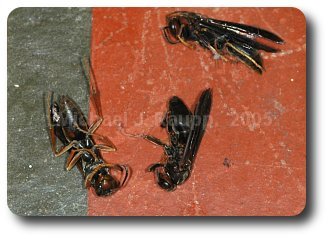A great tale of the Holiday season is one made famous by Clement Clarke Moore in his poem 'Twas the night before Christmas. The image of St. Nicholas bounding down the chimney with his bag full of gifts is a memorable one. You can imagine the surprise of my friend Monica when, instead of jolly St. Nick, several dopey wasps emerged from the chimney and appeared in her fireplace and living room. Was this a sign that someone had been especially naughty this year? Probably not.
Queens that survive the winter found small nests like this one beneath my son's tree fort.
Paper wasps such as Polistes fuscatus and Polistes metricus are two of the most common wasps found in the eastern United States. In the early spring, paper wasp queens that have survived the harsh winter emerge from overwintering sites beneath the bark of trees or from the hollow of someone's unused chimney. They sip nectar, eat juicy caterpillars, and gather wood pulp to construct a tiny paper nest in a protected location. During the spring and summer the queen enlarges her nest and lays eggs that hatch into larvae. Other potential queens who vie for the right to dominate the colony sometimes join her. The queen feeds her babes a variety of food such as caterpillars and beetle larvae. These early batches of children are destined to become sterile workers. When they reach maturity, they help with the rearing of their sisters and brothers but they never reproduce.
Paper wasps eat nectar and many pests of plants in landscapes and gardens.
During late summer, a change takes place in the colony. A new caste of larvae begins to appear in the nest. Some are destined to become queens. The others will be the queen's rather lazy mates, the male reproductives. As the end of the fall approaches, the nest becomes increasingly chaotic. No more workers are developing in the brood and there are fewer workers available to meet the demands of the developing royals. In some colonies food becomes so scarce that battles breakout for the morsels workers bring to the nest. Larvae may be yanked from their cells and eaten by the hungry queens - not nice. Late autumn marks the end of the food supply for paper wasps. Caterpillars are no longer found on plants and flowers no longer produce nectar or pollen. The queens leave the nest and search for protected places to survive the long winter months. Despite their aggressive nature and potent singers, paper wasps are quite beneficial in our landscapes and gardens where they kill many pests. They are like a Holiday gift from Mother Nature; well, unless they are in your living room.
Insects are becoming a bit scarce outdoors and images are becoming increasingly hard to collect. If you have a favorite insect that was not featured in bug of the week, I invite you to email me at mraupp@umd.edu. Send an image, if you have one, and I will attempt to discuss your bug on a future bug of the week.
References:
For more information of paper wasps, visit the following web sites.
http://www.agnr.umd.edu/MCE/Publications/PDFs/EB248.pdf
http://ohioline.osu.edu/hyg-fact/2000/2077.html


